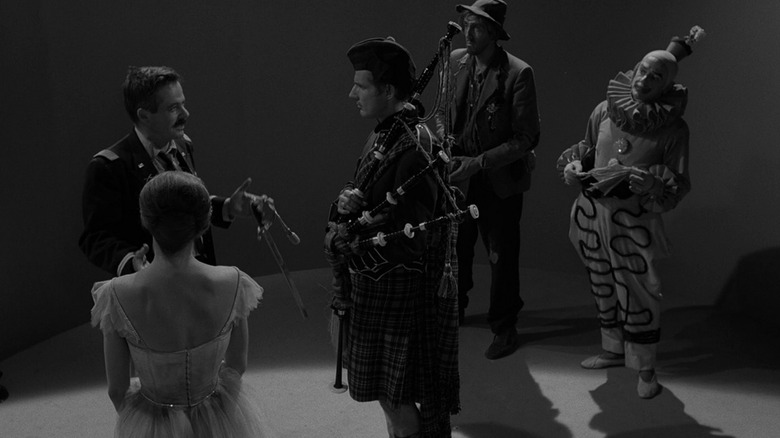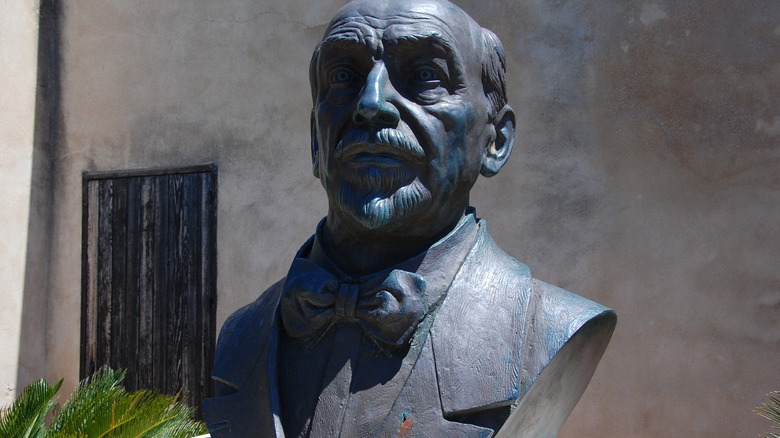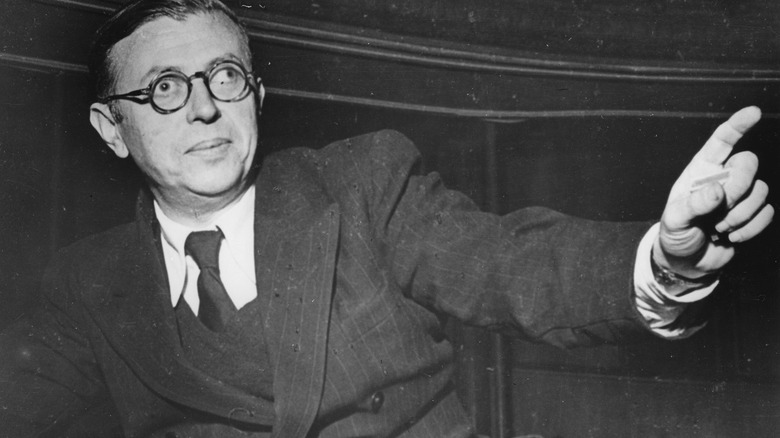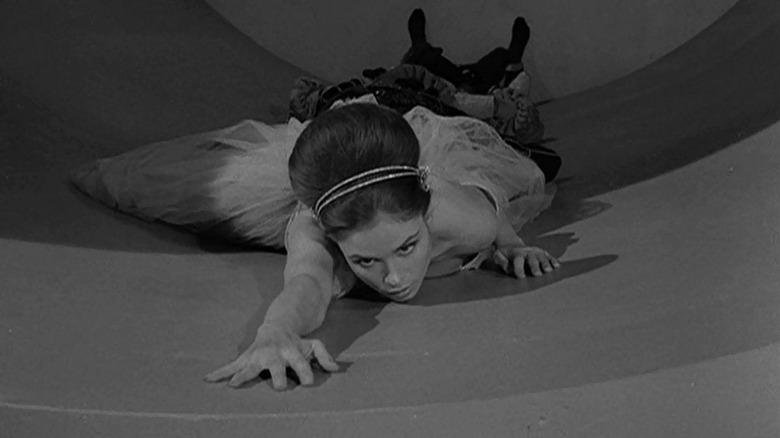The Inspiration Behind Twilight Zone's 'Five Characters In Search Of An Exit'
Spoiler warning: This article will openly discuss the twist ending of an episode of "The Twilight Zone."
The 14th episode of the third season of "The Twilight Zone" first aired on December 22, 1961. To quote the episode's opening narration, spoken by Rod Serling:
"Clown, hobo, ballet dancer, bagpiper, and an army major: A collection of question marks. Five improbable entities stuck together into a pit of darkness. No logic, no reason, no explanation; just a prolonged nightmare in which fear, loneliness, and the unexplainable walk hand in hand through the shadows. In a moment, we'll start collecting clues as to the whys, the whats, and the wheres. We will not end the nightmare, we'll only explain it. Because this ... is The Twilight Zone."
The premise of "Five Characters in Search of an Exit" is that these five characters, played by Murray Matheson, Paul Wexler, Susan Harrison, Clark Allen, and William Windom, are trapped in the bottom of a featureless pit with no memory as to how they got there, what the purpose of their prison was, or what — if anything — they have to do with one another. Climbing out is not an option, as the walls are too smooth. Where is this pit? Why are we here? And what is going on? The truth is eventually revealed: The five characters are not human beings, but toys that have been left in the bottom of a toy dropoff bin. The episode plays like a particularly bleak chapter in the lives of Woody and Buzz Lightyear from "Toy Story."
According to the credits, the episode was based on a short story by Marvin Petal, although it seems the original story was never published and cannot be easily accessed anywhere. Looking at the title, however, one can see two other notable theatrical inspirations for the episode: Luigi Pirandello's "Six Characters in Search of an Author," first performed in 1921, and Jean-Paul Sartre's college syllabus staple "No Exit," first performed in 1944.
Luigi Pirandello
Luigi Pirandello was an Italian author and playwright best known for his plays "So It Is (If You Think So)" (1916), "Henry IV" (1922), and, most frequently performed, "Six Characters." His most celebrated novel is probably "One, No One, and One Hundred Thousand," published in 1926. Pirandello worked in a genre unto his own, which blended modern psychology (he was a contemporary of Freud), broadly self-aware and farcical elements, and deep personal tragedy. Pirandello was a post-modern author, and his plays frequently featured characters who were inseparable from the actors who played them, a quality that scholars refer to as Pirandellian. If you, dear reader, wish to impress a professor, drop "Pirandellian" into an essay. He is often included in summations of Theater of the Absurd, although he technically predates the movement (Theater of the Absurd didn't become codified until the 1950s, with the works of Eugène Ionesco and Samuel Beckett – not to be confused with the character from "Quantum Leap" — and the movement wasn't given a name until 1960 when critic Martin Esslin coined it). One might say he was a precursor.
You can bet that Rod Serling watched these plays and was a fan of Theater of the Absurd. At the very least, the self-aware, post-modernist bent that ran through a lot of pop art in the late 1950s was definitely something Serling keyed into.
"Six Characters in Search of an Author" begins with a troupe of actors on stage rehearsing for "The Rules of the Game," the actual play Pirandello published in 1919 (not to be confused with the 1939 Jean Renoir film). In the middle of rehearsal, six people enter the theater, declaring that they are looking for a playwright. The director asks who they are, and they announce they have no names (they are listed in the script as The Father, The Mother, The Stepdaughter, The Son, The Boy, and The Child), but they do have backstories they seem to remember. They are eventually revealed to be, in a metanarrative twist, personified versions of unfinished theatrical characters. They seek an author to write their stories into a script. Eventually, the actors in "The Rules of the Game" begin performing the roles of the Characters, leading to a lot of arguing. By the end of the day, nothing of value has been produced.
One might interpret "Six Characters" as a literal version of a difficult creative process; Writer's block in live action. The play is easy enough to find.
Jean-Paul Sartre
Any young person who wore black coats, smoked clove cigarettes, rejected the triune God, and spent far too much time in their local coffee house insisting to dates that life was meaningless is likely familiar with the works of Jean-Paul Sartre. Sartre wrote many screenplays, stage plays, short stories, and novels, but is best known for his essays on existentialist philosophy, which confronted the bourgeoise status quo, and disapproved of the way religion encouraged conformity (it is from Sartre that we get the phrase "bad faith"). Sartre argued for a self-intensified life that encouraged a more authentic way of being. College students are frequently assigned his 1943 book "Being and Nothingness," or his 1938 novel "Nausea."
"Five Characters in Search of an Exit" takes not only its title but its setting from Sartre's 1944 play "No Exit," which is about three people who are trapped in Hell, envisioned in the play as a single stark room. As the characters talk, they begin to develop a bizarre love triangle. It is from this play that the oft-repeated Sartrian catchphrase "Hell is other people" comes from. The phrase is one of the more commonly misquoted lines in the history of philosophy, and Sartre himself had to come out often to clarify what he meant. He wasn't saying that other people are the ones responsible making your personal Hell, and that you should hide out from humanity and become a misanthrope. He was saying that, ontologically, we tend to view our own consciousnesses through the assumed perceptions of others:
"'Hell is other people' has always been misunderstood. It has been thought that what I meant by that was that our relations with other people are always poisoned, that they are invariably hellish relations. But what I really mean is something totally different. I mean that if relations with someone else are twisted, vitiated, then that other person can only be hell. Why? Because ... when we think about ourselves, when we try to know ourselves ... we use the knowledge of us which other people already have. We judge ourselves with the means other people have and have given us for judging ourselves.
Five Characters in Search of an Exit
Serling's teleplay for "Five Characters in Search of an Exit" blends the notions from Pirandello and Sartre in an unexptected way. The set-up was from Sartre's play, and the characters began to realize very slowly that there was indeed No Escape, but the characters did not go through an examination of their own selves, concerned that they would be unduly influenced by the perceptions of others. Instead, the clown, the ballet dancer, the bagpiper, the hobo, and the major were from the Pirandellian mold wherein their characters were static and immutable as fictional constructs. They seemed incapable of seeing the world through anything other than the perspective of their divine making.
Divine making? Oh Serling, you scamp, are you mixing theology into your deconstructionist, absurdist mini-play? Perhaps. While Sartre was a humanist, Serling was a humanitarian, preaching against violence and war and encouraging understanding and empathy. He spoke out against war, often supporting antiwar politicians, and hated racism. While many episodes of "The Twilight Zone" ended with an ironic twist or a dark double-back, often containing a moral, Serling was not a misanthrope and mined terror from isolation. Hell is not other people. Other people are necessary.
Pirandello died in 1936. Serling died in 1950. Sartre died in 1980.



